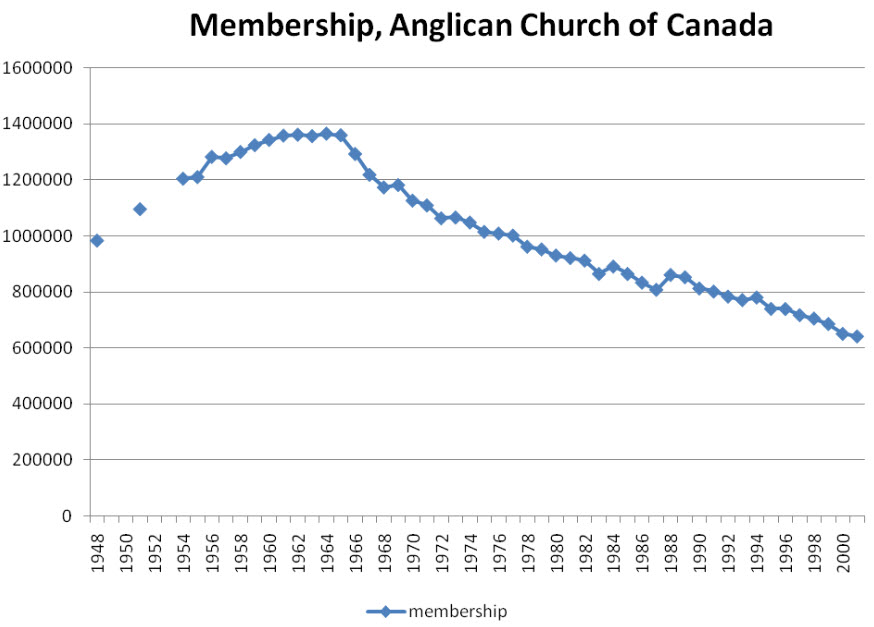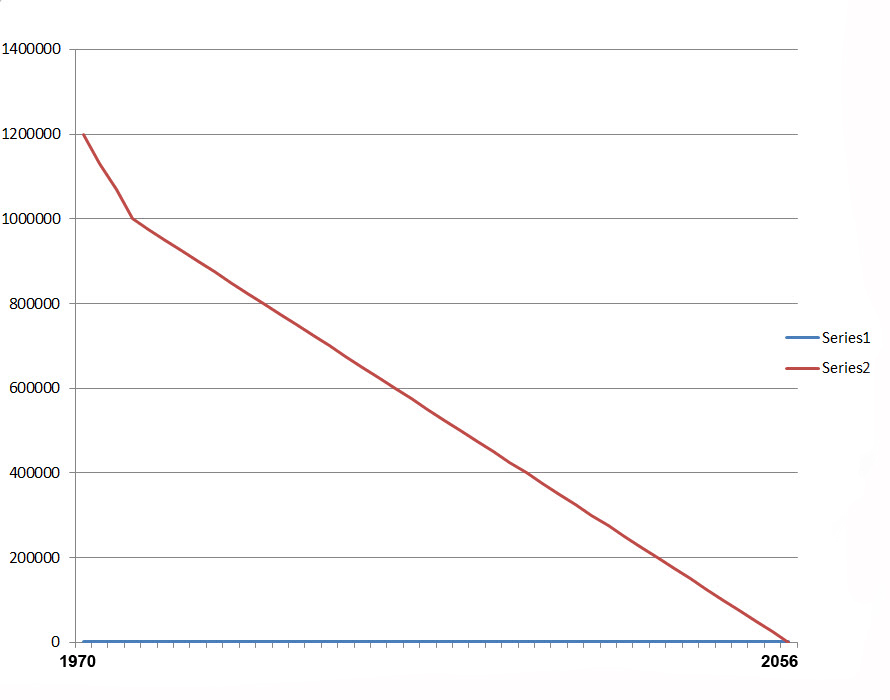Although the “Working Paper – Anglican Church of Canada Statistics” report is from 2010, I hadn’t seen it before. The numbers only extend to 2001 and the numbers are mostly for “membership” in the ACoC and so are far higher than those actually attending church. In 2001 the number of “identifiable givers” stood at just over 200,000; this number is probably closer to the average Sunday attendance at that time. The whole report is worth a look:
We begin our discussion by looking at the national membership of the Anglican Church of Canada after World War II. The membership of the Anglican Church (Figure 1) rose steadily in the immediate post-war period. Starting at just under 1 million members (983,779) in 1948, the earliest year after the war for which we have such figures, membership grew over the next decade and stood at 1,300,029 a decade later (1958). The rate of growth over this ten year period was very high, a remarkable 32% increase. Membership continued to grow consistently for several years after 1958, reaching 1,361,463 members in 1962. Membership then dropped slightly to 1,356,424 in 1963, but rebounded the next year in 1964 to reach a peak of 1,365,313. This was to be, though no one could have predicted this at the time, a record high, one that the Anglican Church would never come close to achieving again.
After reaching a peak in 1964, a significantly different trend emerges as membership moved into steady decline. The initial decline was notably steep. By 1968 Anglican membership had declined to 1,173,519 – a decline of almost 200,000 members in a three year period. In just three years, almost 15% of the church’s membership had vanished from its rolls. There was a small rebound in 1968, as there would be at various times in later years, but the downward trend after 1964 is notable. By 1978 the Anglican church membership had not only fallen below 1 million members, it had also fallen below its membership level of thirty years previously (1948). There was a brief increase in the late 1980s, but this did not reverse the overall trend. By 2001, the last year the church reported such figures, Anglican membership had fallen to 641,845. To put this in perspective – membership was less than half of what it had been at its peak. And, of course, the overall Canadian population had been increasing in this period, with the national population increasing by just over 60% from 1961 through to 2001, that is from 18,236,247 people in 1961 to 29,639,030 in 2001.
I couldn’t resist plugging the numbers from the graph above into a spreadsheet and extrapolating the decline to find the year when membership reaches zero:




I think that this trend is similar to most denominations as highlighted in the recent Statistics Canada “National Household” survey.
As I mentioned in a previous post, many (or most) ANIC churches are also seeing a decline in average attendance so this is not a uniquely ACoC issue.
Hell EdmontonAnglican,
Actually, it is really just the mainline Protestant denominations that are in long-term decline.
Here are some interesting numbers:
Catholic – ’61 8,342,826 – ’01 12,793,125 – 53% increase
Orthodox – ’61 239,766 – ’01 479,620 – 100% increase
Protestants – ’61 8,384,260 – ’01 8,654.845 – 3% increase
source
http://books.google.ca/books?id=qnPOqwsR5UsC&pg=PA361&lpg=PA361&dq=churches+attendance+in+canada+by+denomination&source=bl&ots=wpk09Srxfw&sig=9wq7UE2dfSYi9eGiTre6l0wPuD4&hl=en&sa=X&ei=KXeWUbKiJcPO0gG4xYHQCg&ved=0CFMQ6AEwBQ#v=onepage&q=churches%20attendance%20in%20canada%20by%20denomination&f=false
The organization that produced the report on the Anglican numbers also did similar report on the Presbyterian and United Churches. Similar results were observed. Which leaves one to ask:
If the Anglicans, Presbyterians, and United are all declining, than which Protestant denominations are growing that would account for the 3% increase?
I think Evangelical and Pentacostal mostly. Especially Evangelical, I suspect. Some of them have huge attendance, with multiple services Saturday night and Sunday (day and evening). For example, I know of some Christian and Missionary Alliance churches where I am, where it is difficult to find a seat. Also, I think the relatively few UCC congregations that have kept themselves more or less Bible-based and apart from the UCC mainline are doing alright, but they must have a problem with identity.
I just finished a leadership conference at Holy Trinity Brompton (HTB), home of the Alpha course. In addition to thriving themselves, they have resurrected 3 other dying churches in central London and have planted a least 21 more. Their weekly Alpha course has about 1000 guests with an average age of 27.
The first necessity for a thriving church, in my opinion, is to hold to the truth of the Gospel, as taught by the Church for 2000 years. But having said that, any church, ACoC or ANiC, who is not aiming, by their style of worship and music, toward the twenty- and thirty-somethings, while still accomodating their older members in some way, is doomed to fade away with their gray haired members (I’m 68, by the way, so no personal axe to grind here.)
I have seen and heard of a number of churches that refuse to change from their old ways. I think these people, who refuse to change in secondary matters such as music style, just because they are comfortable with, “the way it has always been” are being quite selfish, and their slow death may quite possibly be well deserved.
Perhaps they counted the Jehovah’s Witnesses as Protestant.
Based on this trend remaining linear, and ignoring the split-off of large ANIC churches, ACoC attendance now is about 400,000. There is no reason to expect the graph to remain linear – boomers are getting old, and departures may accelerate as numbers dwindle – but if it remains linear I think our host is optimistic – this graph hits zero around 2030.
2030— 27 years left?
“But he who endures to the end shall be saved.” Matt.24:13
I don’t know what the future holds, for me, or for the Anglican Church, but I know who holds the future.
ACoC “attendance” is not 400,000. That’s the total figure appearing on parish rolls/lists. Based on other mainline protestant average weekly attendance figures I’d estimate fewer than 100,000 people are appearing in ACo churches on an average Sunday.
I agree with your estimate of 100,000. I expect less than 20,000 on a Summer long weekend.
I can’t help noticing, on this graph, that decline starts in about 1966, before which there is a gradual ascent. I wonder if this is borne out by figures of, say, the Church of England? I wonder if the relentless attack of the media, and the “new morality” (=the old immorality), which accelerated after the mid-’60s, was a major factor here.
The research company that produced the report from which the chart was obtained also did similar reports for the United Church and Presbyterian Church of Canada. The corresponding membership charts for both of them is remarkably similar to the Anglican chart. One of there preliminary conclusions was that as these declines were being observed across numerous denominations the cause of was most likely an external factor. However this conclusion seems to have ignored other information from another report (available in many Canadian university libraries) that indicates from 1961 to 2001 the Roman Catholics membership increased by approximately 50%, the Orthodox membership increased by approximately 100%, and the Protestant membership increased by approximately 3%.
Didn’t the ACoC announce it was abolishing the devil, in or around 1964? I seem to remember a Len Norris cartoon in the Vancouver Sun around that time, based on that news article.
Remarriages after divorces, ordination of female priests and secularism in general may have contributed to the decline since 1966.
The mid-sixties period was the start of the unfortunate New World Order in the West, so I have always assumed the two issues were intimately intertwined.
The ACOC has clearly denounced any allegiance to our Lord and Saviour despite any claim to the contrary. We have a primate and most of the so-called bishops who readily abandon either or both the authority of Scripture or the uniqueness of Jesus Christ. To be an Anglican one must be a Christian and tragically despite the colour of their shirt or collar many so-called bishops including the primate and other clergy have turned their back on the truth. Until these facts are corrected the ACoC will continue in its freefall.
Should we assume that apostasy is always terminal? In 1979, Richard F. Lovelace said, “Even when life and faith lapse very drastically in one generation of the church, we are responsible to pray for the recovery of the next generation and to present it with a clear proclamation of the Gospel”. Lovelace believed that “God is faithful to His covenant people in succeeding generation even if the present generation has gone whoring with false prophets”. Moses and an entire generation of his people were not allowed to enter the Promised Land, but the next generation did.
You are quite correct. That is why my comment is “until these facts are corrected the ACoC will continue in its freefall”. Currently there seems to be no one within the ACoC to call the apostates into account.
After 20 years growing up as a conservative evangelical Christian, I walked into an Anglican service — an Episcopalian cathedral parish in a conservative corner of the U.S. My then girlfriend (and now wife of 30 years) and I were moved to tears by the spiritual beauty of the total experience — music, liturgics, vestment, architecture, language (Rite I) everything. I thought I had discovered what I had been looking for all of my Christian life.
I gradually discovered over the next few years that all had already been lost (or destroyed) from a theological/moral standpoint. I later learned that the rector of that cathedral was gay, that the bishop had kicked out priests who opposed the ordination of women, and I began to catch the carefully worded heresy in many Episcopalian sermons.
I have now been Eastern Orthodox now for nearly 25 years. I love Orthodoxy, have grown to love the beauty of its worship and the depth of its spirituality. I never need to wonder if it is Christian — or if a Christian from 100 or 500 or 1000 or 1500 years ago would recognize it as being Christian in either worship or in theological and moral teachings.
But my language and culture are still, at root, the product of northern Europe in general and the British Isles in particular. So my heart still thrills at the sight of a traditional Anglican church, or at listening to the Coverdale Psalter sung to one form or another of Anglican chant. All these years later, the loss still hurts, and I occasionally even feel a twinge of anger at those who destroyed it from within.
It has been said that Anglicanism was never really a church, but was rather a quasi-religious organization that just reflected the morals and prejudices of the Anglo upper crust. I didn’t want to believe it when I first heard it, but after watching how obedient Anglicanism was to the spirit of the age, it is hard to disagree anymore.
Pingback: Interlude: A Tale of Two Churches | This Rough Beast
Pingback: What’s happening to Canadian churches?